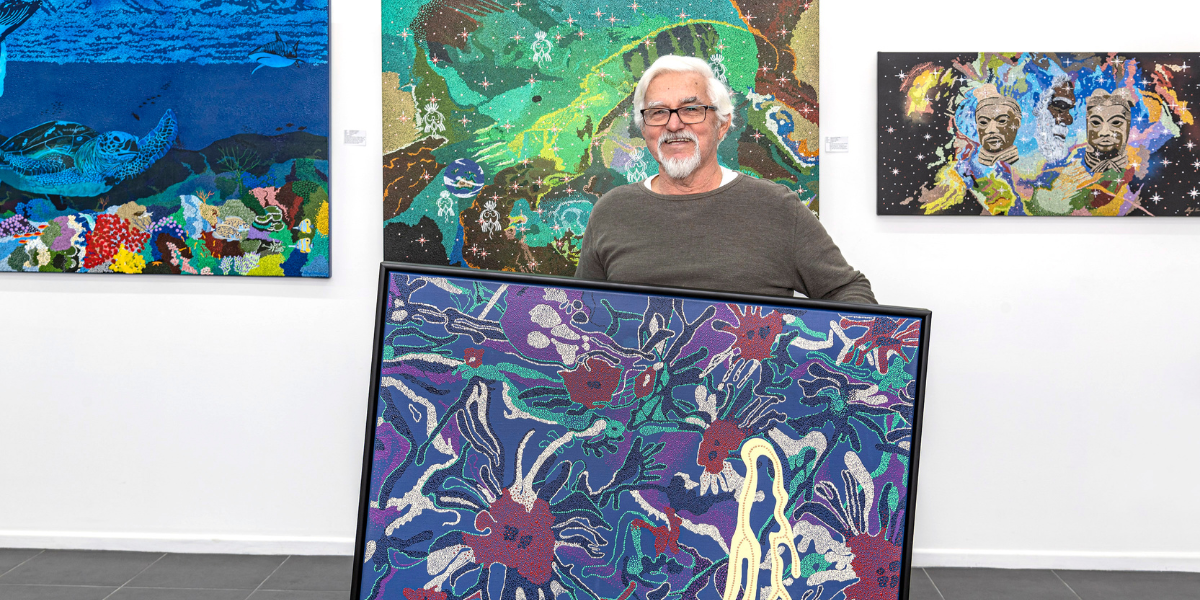Glen Innes artist Lloyd Hornsby has had his fair share of success over the years. He’s been asked to contribute art inspired by part of his heritage to a world tour, and exhibited at the Biennale in Europe.
The 77 year old internationally recognised artist and descendant of the NSW Aboriginal Yuin People has also had works displayed at the Cannes Film Festival, had artwork chosen for the United Nations (UN) report on the treatment of Aboriginals, and even been asked to send a painting to the Louvre in France.
“I was approached to send some of my work on a world tour with a couple of other artists; they’ve got a collection they want to send around the world,” Lloyd said.
“My makeup is Aboriginal, Chinese and European. My great grandfather was Chinese; this collection is all about the Chinese side of things; they wanted me to do a piece on China. Never been there, but I had a mate that goes there quite often, and he’s given me a lot of postcards.”
According to Lloyd, so far he’s “enjoyed every minute of” the ride as a full-time artist, with many memorable moments during his career. However, two in particular stick out in his mind as moments of pride that he looks back on.
His first exhibition sold $50,000 worth of art. Later, a painting, which sold long ago, provoked some heavy emotion from everyone who saw it.
“One of the first ones I ever did was Creation. I actually did that when I first started off, it had Earth in the middle and all the native animals in Australia. I thought Australia on the planet, and the animals are heading towards Australia. It’s called Creation,” Lloyd said.
“It made people cry, made women cry. My first exhibition with it, this woman was feeding her baby and looking at it. After a while, I realised she had been staring at it for quite a while.
“I went up to her and saw she was crying, and I said, What’s the matter? And she said, This painting is drawing me into it. I feel like I’m part of the painting. She wasn’t the only one that got emotional about it either; it’s made a few people cry,” he added.
Lifelong passion results in full time profession
Lloyd decided to pursue an artistic career relatively late in life, but the passion was always there. Upon leaving school, Lloyd trained as a Commercial Artist, which led to a job as a window dresser.
However, he ultimately found himself working as a metal polisher in the aluminium industry and eventually, a manager at an anodising plant.
Before that the 77 year old dabbled in various art forms, even creating gifts of paintings and carvings for childhood sweetheart Wendy, now wife.
“I’ve always been arty; when I was a boy, I used to do portraits of dogs, cats and girls and boys, and that’s when I was only around about 15,” Lloyd said.
“Nowadays, I work between a toothpick and a pencil. I have whole paintings done with a toothpick, it can be very time consuming, especially on the big ones.”
Years later, at the age of 60, Lloyd made a pretty significant discovery: he wasn’t a Kiwi from the New Zealand city of Rotorua, as he had always been told.
After decades of hiding it, his family revealed to him that Lloyd was part of the Yuin nation in south-east New South Wales.
Inspired, he dedicated himself to filling in the gaps and soon decided to reconnect with his artistic passion.
Journey of self discovery leads to art
Sadly, Lloyd’s journey of self discovery wasn’t always pleasant. While studying contemporary Indigenous art, he learned about the stories of the Stolen Generation and other past atrocities Aboriginals faced.
“I decided to go to university to learn all about Aboriginal Studies and history when I was 60. I graduated from Griffith University in Brisbane in 2009,” he said.
“I spent a lot of time in the toilets crying to be honest, I’d get very upset about watching what was done and learning about what happened.”
During this time, he also discovered the bond his people, the Yuin nation, have with Orca’s, also known as killer whales.
Using a combination of his heritage and actual images of galaxies and star systems, he quickly found his niche. Once he identifies a group of stars, he envisions an Aboriginal story to weave into it.
“The coastal Yuin nation has a long connection with Orca’s. There’s this area called Twofold Bay, near the port of Eden in New South Wales, and there is a famous story about Orca’s helping people hunt other whales,” Lloyd said.
“To my knowledge, it’s the only place in the world where this has happened.”
The port of Eden in southeastern Australia famously had a pod of killer whales operating in the area between 1840 and 1930 that would assist whalers. Led by their leader, an Orca known as Old Tom, there are several theories on why the whales acted this way.
According to Loyd, Orca’s used to exhibit similar symbiotic behaviour with the Aboriginals in the area going back many years.
“The same thing used to happen with Aboriginals. Orca’s would chase the smaller whales, then people would go out retrieve the bodies, carcasses of the ones that the Orca’s had killed,” he said.
“Sometimes, an Orca who would get beached send out a distress call, and the Aboriginals of the area learnt that noise meant an Orca was in distress, so they would go out there and push them back in the water.”
Gallery opening and giving back
In addition to his work as an artist, Lloyd has spent considerable time trying to give back to his community through various initiatives, including raising a quarter of a million dollars for Indigenous heart research with other artists.
“I got heavily involved with travelling to Aboriginal communities and trying to teach kids about their history and beliefs. The only way you can do that is through art,” he said.
“I spent a fair bit of time working with communities all over Queensland and northern New South Wales. I also created an art therapy program for Aboriginal prisoners in Arthur Gorrie and Woodford.
“Even today, people come into our gallery and say, a young boy or a young girl shows interest in the art, I’ll give them paints in containers, and I’ll give them a canvas to get them started,” Lloyd added.
In more recent times, Lloyd and Wendy opened the Gawura Gallery in Glenn Innes in 2017, which serves a dual purpose as a gallery and a way to educate people about the history of Aboriginal people.
Wendy says it had always been “a dream of ours to have a gallery and live on site.”
“People will quite often come into the gallery, and when they learn about the meaning behind some of the art, they can get a bit emotional, the paintings often have an effect on people,” she said.
Lloyd and Wendy said some of the stories they tell are first-hand experiences that provide an extra level of interaction for visitors to the gallery.
“Wendy and I spend a lot of time talking to people about the art, she will spend at least a half hour to maybe sometimes three quarters of an hour,” Lloyd.
“A big part of the reason we set up the gallery was to educate people. Often, we will tell someone a fact about Aboriginal history, and they will leave saying they haven’t heard that before. It’s not about laying blame, it’s just history; people should know more about history.”
Like what you’re reading? Support The New England Times by making a small donation today and help us keep delivering local news paywall-free. Donate now.


